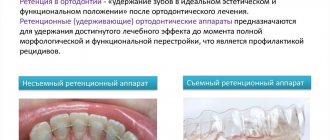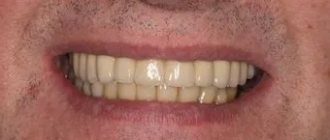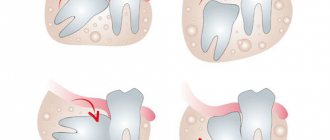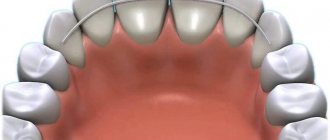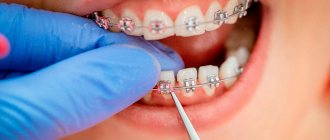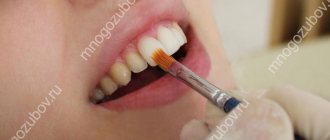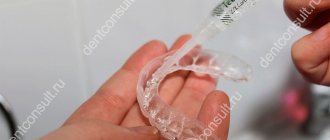28.11.2019
At the moment when the doctor informed the patient that the treatment process is over and that the braces system can be removed, teeth whitening after removing the braces becomes the most significant and important aspect for the client of the dental clinic. This is explained simply, because having received the desired result in the form of an even and beautiful row of teeth, the patient often faces unpleasant side effects in the form of stains on the tooth enamel. To get rid of such troubles, it is necessary to perform whitening so that no plaque or tartar remains on the teeth.
Is it possible to whiten teeth after braces?
It is not difficult to understand a patient who, after removing braces, suddenly discovers spots of different colors on his teeth; his desire to whiten looks quite natural. Of course, you can whiten your teeth after removing braces, but you will have to wait a little, about a month, before starting this procedure. By the way, there are also situations when a specialist recommends increasing the waiting period due to the individual characteristics of the patient’s oral cavity and the poor condition of his teeth. Whitening is based on a chemical reaction, as a result of which the released active oxygen penetrates the upper layers of the teeth and brightens them. Such an intervention is stressful, hence some pain experienced by the patient after its completion.
In any case, there is no need to rush, even if the appearance of the jaw is so smooth and beautiful because of its color. There are two important aspects that support this statement:
- during the waiting period, the enamel will be restored and will no longer be depleted and weak;
- the natural color of some areas can be restored without external aggressive intervention.
How to do whitening?
The teeth whitening procedure is one of the most effective and highly popular among dental patients. Its rather high cost is not the most pleasant moment, but the result obtained justifies all financial investments and costs.
When contacting a dentist with a similar problem, you can count on the following methods to solve the problem:
- hygienic cleaning with the help of which removes plaque and tartar, and also restores the natural color of the enamel;
- laser cleaning, which requires perfect cleanliness but gives excellent results;
- the use of special whitening strips that remove the yellow color of teeth and return them to their natural color.
Advantages and disadvantages of whitening
The key advantage of the whitening procedure is manifested in a person’s beautiful snow-white smile. In addition, yellow teeth are not only not very beautiful, but also not very stable, and this is not only a problem with the appearance of the teeth. Whitening makes it possible to get rid of plaque and tartar, prevents the growth of bacteria in the oral cavity, and accordingly the risk of developing caries is reduced.
However, whitening also has disadvantages, in particular the likelihood of certain complications, which are not difficult to avoid; it is necessary to visit the dentist in a timely manner to diagnose the condition of the enamel.
The main properties of pastes for braces
When wearing braces, food debris gets stuck in hard-to-reach places - around the bracket, under the arch, in the interdental spaces. Plaque that is not removed in time hardens and turns into tartar. In such conditions, bacteria begin to actively multiply, which threatens inflammation of the mucous membrane and destruction of the enamel. To prevent the rapid growth of bacteria, toothpaste must meet several main criteria.
Abrasiveness
The paste should remove plaque well. Therefore, when wearing braces, you need to choose pastes with abrasives or enzymes. Abrasives are small hard particles that mechanically clean the surface of teeth. The degree of abrasiveness is indicated by the RDA index - the higher the index, the larger the particles.
Pastes with an index of “0” do not mechanically clean plaque, and pastes with an index of more than 100 are considered lightening and can thin out the enamel. The optimal solution for braces would be pastes with an abrasiveness index from 75 to 100.
Enzymes are plant components that safely break down plaque. Most often, papain (a substance from the papaya fruit) and bromelain (from the pineapple stem) are found in the pastes.
Strengthening enamel
While wearing braces, the enamel around the clasps is subject to heavy stress. Braces themselves do not damage the enamel, but thinning occurs due to poor hygiene. If plaque remains on the tooth, the bacteria in it begin to produce acid. It deprives teeth of calcium and phosphorus, causing white spots, which already indicates the initial stage of caries development. Therefore, for daily hygiene you need to choose pastes that strengthen the enamel - for example, with fluoride, calcium or hydroxyapatite.
Antibacterial effect
To destroy pathogenic microflora and relieve inflammation in the gums, pastes with chlorhexidine or metronidazole are well suited. These substances destroy bacteria, fungi and protozoan microorganisms.
Please note that such pastes can only be used in a course, and the higher the concentration of the antibacterial substance, the shorter the course. If you use the paste for longer than necessary, along with the dangerous bacteria, the beneficial ones will also die, which will lead to disruption of the natural defense mechanisms.
For every day, it is better to choose a paste with natural antibacterial ingredients - such as bisabolol, zinc salt, xylitol, chamomile and sage.
Why is there a need for teeth whitening?
A very common unpleasant surprise for patients who have undergone treatment with braces, which is not possible to predict in advance, is a change in color in areas of the enamel not covered by the system. The most likely cause of such unattractive stains is eating foods with dyes, smoking and insufficient attention to oral hygiene. The bracket system serves as reliable protection against darkening, but after its removal, a real color imbalance is observed, which has to be restored with the help of bleaching.
Pastas for every day
These are pastes that clean well, strengthen and have a moderate antibacterial effect. They do not contain chlorhexidine or similar components and can be used every day.
Toothpaste ROCS PRO Brackets & Ortho
PresiDENT PROFI ORTHO BRACES toothpaste for braces
Philips Sonicare BreathRX toothpaste
Biorepair PLUS Total Protection toothpaste
Three ways to solve the problem
The problem of darkened enamel can cause serious inconvenience not only after removing the structure, but also during its wearing. In this case, the option of removing the system and performing teeth whitening is acceptable, but this is only permissible in a frankly advanced case, as well as if the patient has very decent funds, because you will have to pay for the additional work of a specialist. In all other situations, there are two other ways: teeth whitening after removing braces professionally or at home.
Features of teeth whitening after orthodontic treatment
There are many different methods that can successfully answer the question of how to whiten teeth, but not all of them are suitable for a patient who has just finished wearing braces. That is why it is so important to carry out this procedure only with the help of a specialist, using exclusively professional techniques. Each person has his own individual characteristics of the mucous membrane and enamel; accordingly, the selection of the necessary whitening gel, its composition and the concentration of the necessary substances in it must be carried out by a specialist. If this aspect is ignored, then the lack of the expected result will be less of a nuisance, but it will be much worse if serious damage is caused to the enamel.
Note: It should be understood that for teeth, especially if they have been damaged or weakened after installing and removing the braces, whitening is a serious stress.
Therefore, teeth whitening after removing braces should be performed no earlier than a month after their removal, so that the enamel has time to strengthen and the teeth to adapt to the new shape. True, whitening is not required in all situations; it happens that it will be quite enough to remove plaque without resorting to more radical solutions.
Summarizing all of the above, we can formulate three key rules for teeth whitening after the braces are removed:
- Use only professional techniques.
- You can start whitening after removing the system after a month.
- It does not always make sense to perform whitening; after consultation with a doctor, you can limit yourself to professional teeth cleaning.
Is it necessary to carry out hygienic cleaning before installing braces?
If there is evidence for this, then it is necessary, since braces must be installed on clean enamel. It is important that there is no accumulation of plaque underneath them, otherwise caries may develop under the braces. In addition, if there is a lot of plaque, it will be difficult to remove it with braces - it is better to do this before the system is fixed.
However, if you have recently had dental hygiene, it is better to postpone the procedure a little and go through it 2-3 months after installing the braces system - it will be much more effective.
Types of teeth whitening after removing braces
Existing teeth whitening techniques can rightfully be called unique and specific, but they all have common features:
- The whitening procedure should be preceded by a diagnosis of the enamel and its condition, because if it is severely weakened, then chemical intervention will cause even more harm to it, accordingly, it will first need to be strengthened;
- in all cases, a key role is played by a special gel made taking into account the individual characteristics of the patient;
- the basis of the bleaching agent is made up of chemical elements such as hydrogen and carbonate peroxide, the concentration of which is approximately 20%;
- the whitening effect is achieved due to the release of active oxygen that penetrates the enamel as a result of a chemical reaction;
- Upon completion of whitening, it is necessary to perform procedures to strengthen the top layer of teeth.
The main difference between different bleaching methods will be in the methods of accelerating the reaction, which in turn directly affects the final result of the entire process.
What to do if your braces chafe?
For inflammation of the mucous membranes, you can use special gels and ointments that have an antiseptic and soothing effect - for example, Metrogyl Denta, Vinilin.
To prevent inflammation, it is also recommended to use orthodontic wax. The purpose of its use is to isolate and protect soft mucous membranes from solid elements of the system. Apply to sharp protruding parts and replace as they fall off. It is recommended to remove the wax while eating.
Silicone strips for braces, like wax, are used to protect soft mucous membranes. Silicone is presented in the form of strips that can be used to cover one bracket or the entire row. Unlike wax, it does not crumble and is used repeatedly.
Preparing for whitening in the clinic - teeth cleaning
When the orthodontist has completed the procedure for removing braces, he then proceeds to the procedure of professional teeth cleaning, which involves the following operations:
- Elimination of glue residues from enamel. It is a well-known fact that the clasps of the braces structure are attached to the teeth using an adhesive base. Some of this substance remains on the enamel after removing the system, therefore, it must be completely removed.
- The procedure for removing plaque and tartar, without this it is not possible to perform whitening.
Let us assume the option of using special trainers, which in this case will be used with a bleaching composition.
Cleaning before braces: why is it needed?
Correction of the bite always begins with sanitation of the oral cavity. In addition to treating diseases of the teeth and gums, it includes mandatory professional cleaning before installing braces. The doctor will remove hard deposits with ultrasound, and soft deposits with a thin and powerful jet of cleaning powder solution (AirFlow technology). After this, the teeth will need to be polished with a special paste and coated with a fluoride-containing preparation to strengthen the enamel. Such a hygienic procedure should be carried out 3 - 5 days before installation, but no later than 24 hours.
What happens if you don’t brush your teeth before braces? Bacterial plaque will get under the elements of the system, in particular under the clasps that are glued to the enamel. Considering that orthodontic appliances are worn for a year at best, and two years on average, microorganisms will have enough time to multiply and lead to the formation of caries. It is impossible to properly cure it with braces on the teeth. There is a risk of early removal of the device, and this will spoil the final result, and the patient will waste money, time and moral strength. This is why brushing your teeth before getting braces is mandatory.
Be patient
Many patients, who are ready to amaze the world with their truly snow-white and dazzling smile after removing braces, almost panic when they see darkened spots on their teeth and immediately intend to carry out the whitening procedure. You should not rush; you will need to wait at least a month, or even more, for the tooth enamel to return to normal and recover after wearing braces. Moreover, it happens that after some time it returns to its usual appearance on its own and bleaching becomes an absolutely unnecessary operation. In addition, you should always remember that its action is based on a chemical reaction, which is aggressive in nature; you should weigh everything well and think it over before exposing your teeth to such effects.
Gentle method
This problem may have a simpler solution that does not require such radical measures, namely the most common hygienic action based on the use of AirFlow water-abrasive cleaning. Its use eliminates the negative impact on enamel, since it does not involve the use of aggressive chemicals. Many experts recommend performing this cleaning method first after removing the system, and if this option does not give the expected result, then after some time the issue of bleaching can be put on the agenda.
How to whiten teeth at home?
This may seem strange, but at home it is quite possible to get very good whitening results using the following techniques:
- the use of whitening gels, which give excellent and, very importantly, long-lasting results;
- the initial stage of tartar and plaque can be easily removed by regular brushing of the teeth and mouth, which should also include the use of dental floss and rinses;
- using herbal infusions, for example, sage leaves, which will have a beneficial effect on the condition of the gums.
Cleaning and whitening at home should be carried out with a high degree of accuracy and caution, because teeth have become more sensitive, and any aggressive impact can have the opposite effect on them than expected.
What hygiene products are there for braces?
Modern manufacturers produce a huge number of various products and devices that provide complete oral hygiene and high-quality care for braces. The most popular and effective among them are:
- V-shaped brushes. They differ in the shape and location of the villi, ensuring penetration even under the braces.
- Multi-tuft brushes. Such designs are designed to eliminate plaque in the interdental space. The hardness of the pile is of great importance.
- Cleaners. This is a pen-holder with a metal rod, into which nylon pile is woven. The working element can be conical or cylindrical, and the user decides which shape is more convenient for him.
- Irrigators. This device removes plaque using a jet of water. Water is supplied from a special container built into the handle of the device.
- Flosses. These are special dental flosses that allow you to clean not only the space between the teeth, but also the elements of the system.
Lemon
The ascorbic acid contained in lemon is beneficial not only for human gums, but also for the entire body. As for whitening with lemon, there are many options for this procedure, the simplest of which involves using one slice of a simple lemon to treat the enamel. Let’s also say a method based on adding a few drops of lemon juice to the toothpaste, which, by the way, will also help with bleeding gums.
Such products should be used carefully, no more than once a week; those who have increased tooth sensitivity should be especially careful.
Category Hygiene Published by Mister stomatolog
How to care for braces after eating
Caring for braces requires thorough adherence to the rules of oral hygiene. There are several rules for caring for structures that guarantee a beautiful smile and straight, healthy teeth. At the same time, hygiene will not require any special effort from a person - just a little more attention to one’s health than usual. To avoid the development of diseases, you should follow simple rules of care:
- Use special accessories. To ensure that food debris is completely removed from the teeth, it is important to use special devices made specifically for this purpose. They will provide soft and delicate cleansing of the interdental space and enamel.
- Avoid eating solid foods. There is no need to create a special diet, but it is better to temporarily exclude nuts, roasted vegetables, crackers and other hard foods.
- Rinse your mouth after every meal. Rinsing can be done with plain water or special products that strengthen the gums and are sold in any store.
Thus, all that is required from a person is more careful attention to dental health. To prevent diseases, it is recommended to visit the dentist every 3-6 months.
